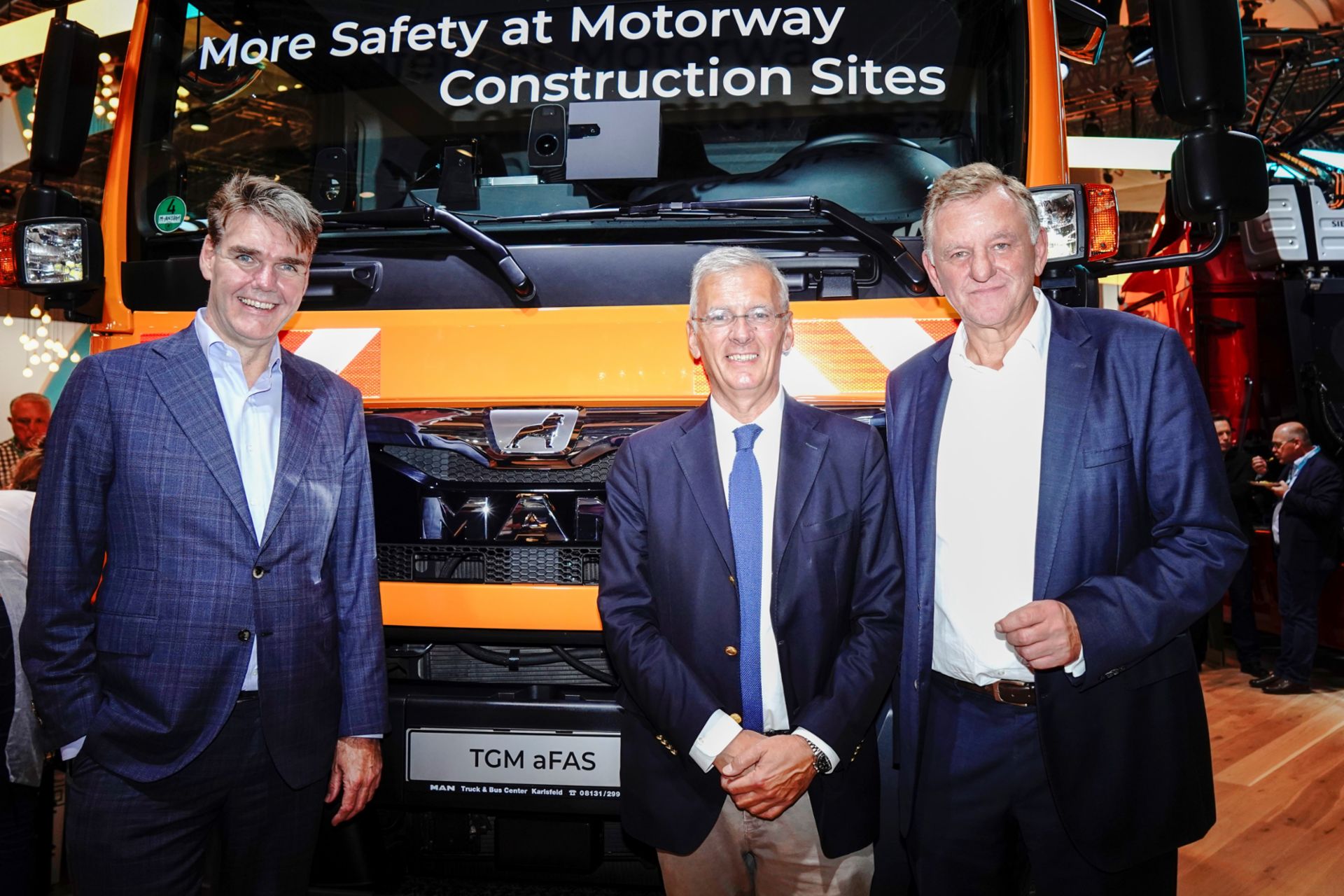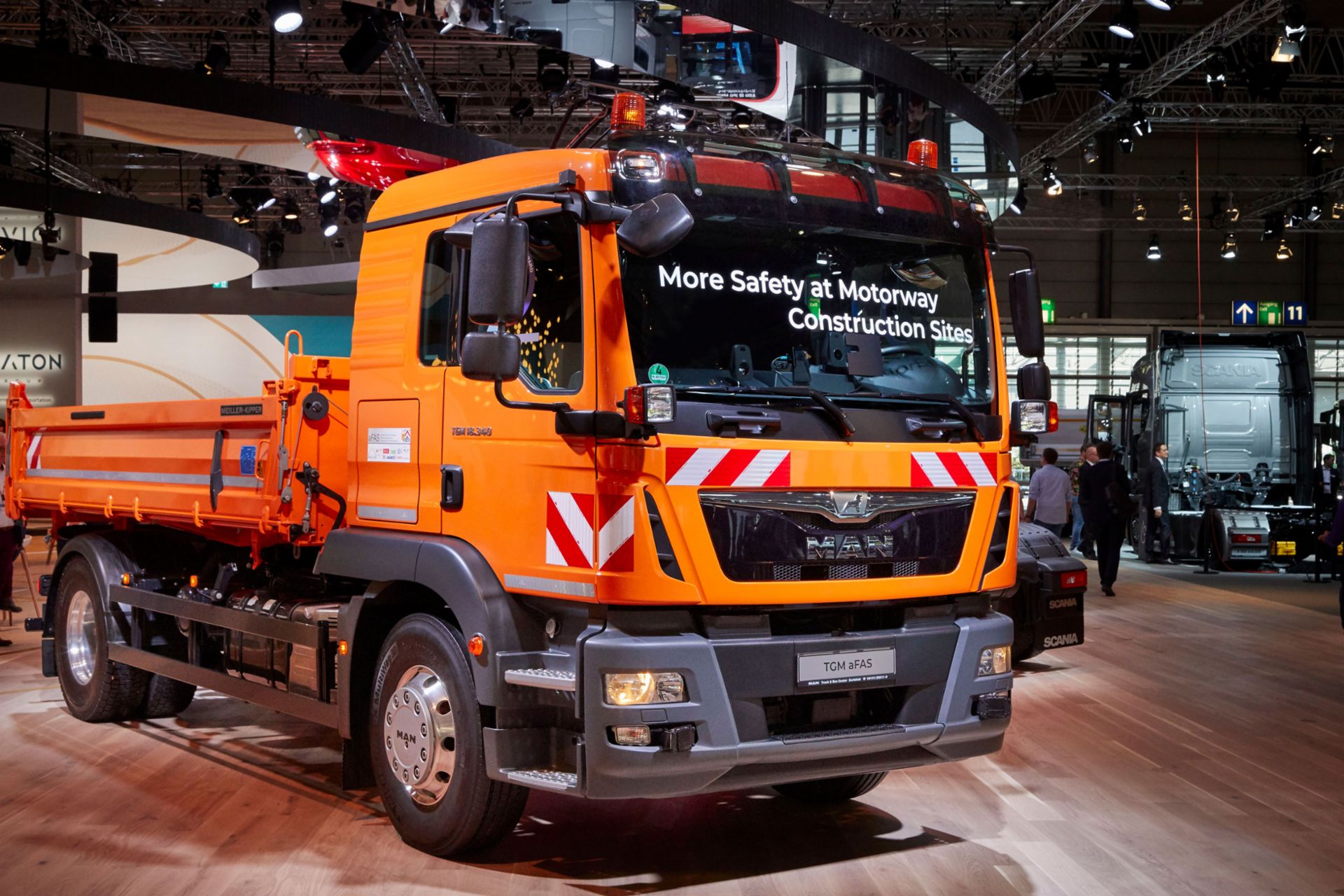Hanover, September 19, 2018. MAN’s autonomous and unmanned safety vehicle aFAS is celebrating a double premiere at the IAA where it can be seen at the TRATON stand in hall 12. The vehicle is being presented to the general public for the first time and it also scooped a special award on September 19, awarded itself for the first time at the IAA 2018: the “Truck Innovation Award 2019” innovation prize conferred by the International Truck of the Year (IToY) jury for the first time. Collecting the award at the Press Day, MAN Truck & Bus CEO Joachim Drees said: “We are honored to receive the award for aFAS and it underscores the great importance of researching automated driving in practice in public traffic.”
MAN’s aFAS won the jury over with its “enormous technological progress enabling autonomous driving at level 4,” said Jury Chairman Gianenrico Griffini. He added that the journalists had impressed the Jury in particular with the fact that this vehicle had already done 4,000 kilometers on public roads without any accidents and that the driverless truck was easy to handle as well as equipped with numerous active security systems. Griffini’s conclusion: “With the afAS project, MAN has not only found an effective solution to secure mobile roadworks but also produced pioneering insight into the future of autonomous driving.”
The acronym aFAS is derived from the German meaning “automatic driverless safety vehicle for work sites on German highways.” Although conventional safety vehicles pull along a trailer behind them with an illuminated warning sign that is four meters high, accidents always happen because the crew is overlooked or spotted too late. MAN Truck & Bus joined forces with seven other partners in Industry, Research, and Administration in a research project entitled “aFAS” to develop a forward-looking mobile solution for this security risk: “cover” that does not need anyone at the wheel in dangerous situations. aFAS is a safety vehicle prototype that can follow mobile roadworks in the emergency lanes fully-automated and driverless and that protects the roadwork crews and other roadwork vehicles from moving traffic.
The research project began back in 2014, was scheduled to run for four years, and received funding totaling €3.4 million from the German Ministry for Economic Affairs and Energy. It first examined the technical feasibility in full and also looked into the extent to which current standards and legislation would have to be changed as well as the impact of real-life operation on public roads.

Working together with other technical project partners, MAN developed the automated safety vehicle and was responsible for the driving function, radio communication, HMI (human machine interface) and the vehicle as a whole.
The test vehicle was an MAN TGM 18.340, which was equipped with cameras and radars for environment sensing as well as various assistance systems. The steering and braking systems, sensors, and control software components had to meet the strictest of criteria. The prototype vehicle largely materialized using series components for both regular control and for the implementation of functional security aspects. Additional, specially designed surround sensors with a high security level and integrated, reliable object and lane recognition also enable data on route characteristics and traffic situation to be analyzed. Data is communicated between the work vehicle at the front and the safety vehicle at the back via W-LAN and displays in both vehicles show the operating status of the driverless prototype.
Once drivers have activated all the systems and the TGM cab has left, it steers, accelerates, and brakes independently and follows the vehicle in front at a set distance. In the event of malfunction, it automatically comes to a standstill. In order to pass critical spots like entries and exits, the prototype can be brought forward up to a few meters to the vehicle in front and be digitally “hooked up.”
After the system was tested on MAN’s test routes in the first few years and then on sectioned-off roadwork sites in Hesse during the second half of 2017, the vehicle went back to developers in Munich. The experience gained enabled the MAN TGM prototype to be optimized further and be put back on the road at the start of April 2018 for real-life piloting on the Hessian highways.
The “aFAS” project was successfully completed in June. The insight gained will be used at MAN in future series developments and further test and research projects involving automated and autonomous driving, such as platooning.
Garnering a total of 93 votes, MAN’s aFAS prevailed against the competition, which comprised five other candidates, to scoop the Truck Innovation Award. A requirement to compete for the new Truck Innovation Award is the existence of progressive and pioneering technology. The vehicle has to have a gross vehicle weight of more than 3.5 tons and should be equipped with an alternative drive, like a hybrid drive or an electric drive, or use alternative fuels. Vehicles with specific high-tech solutions in the field of connectivity are also able to put themselves forward. Examples include partial- or fully-autonomous driving systems as well as platooning-compatible trucks or vehicles with forward-looking services like remote diagnostics.
Contact:
Julia Kroeber-Riel
Head of Group Communications & Governmental Affairs
TRATON AG
Dachauer Str. 641
80995 München
Tel.: +49 152 58870900
julia.kroeber-riel@traton.com
Dr. Alexander Baer
Trade Media Relations
TRATON AG
Dachauer Str. 641
80995 Munich, Germany
Tel.: +49 152 58867423
alexander.baer@traton.com
About TRATON:
TRATON AG, formerly Volkswagen Truck & Bus AG, is a wholly-owned subsidiary of Volkswagen AG and a leading commercial vehicle manufacturer worldwide with its brands MAN, Scania, Volkswagen Caminhões e Ônibus, and RIO. In 2017, the TRATON GROUP’s brands sold around 205,000 vehicles in total. Its product range includes light commercial vehicles, trucks, and buses that are manufactured at 31 sites in 17 countries. The Company had a workforce of around 81,000 worldwide across its commercial vehicle brands as of December 31, 2017. The Group seeks to transform the transportation system through its products, its services, and as a partner for its customers.
